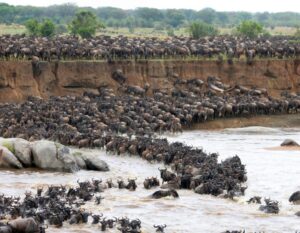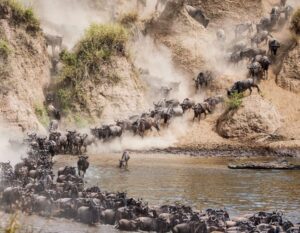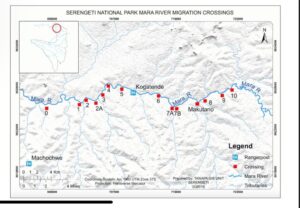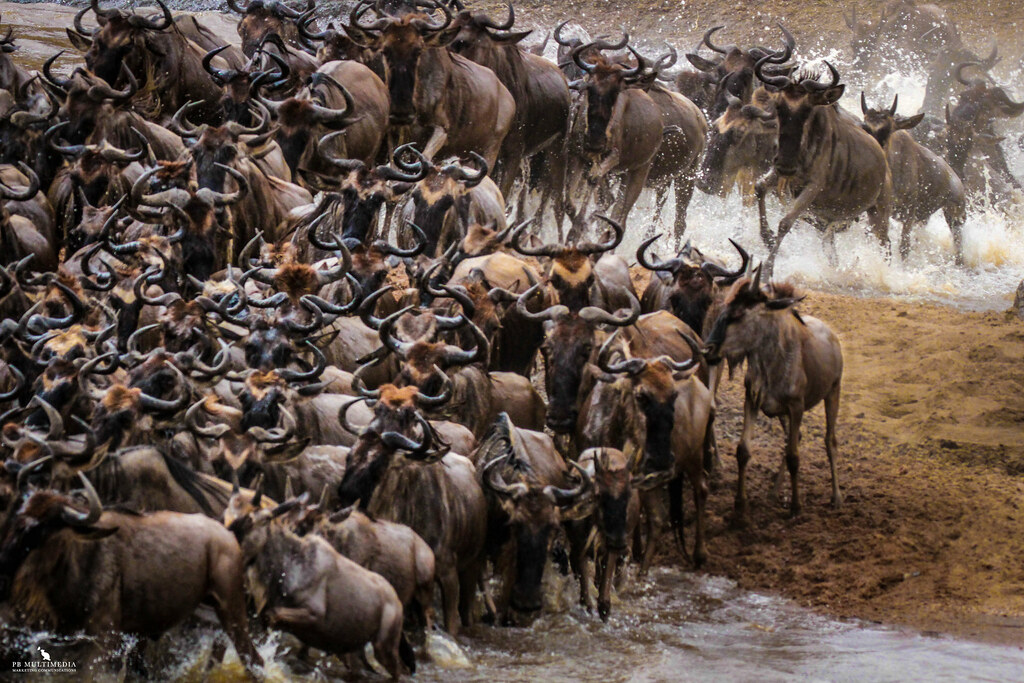Mara river crossing of wildebeest
Every year, over 1.5 million wildebeest, along with zebras and gazelles, migrate in a vast loop through the Serengeti and Masai Mara ecosystems. The Mara River crossing is the most iconic and perilous stage of this journey — known for swift currents, steep banks, and lurking predators
Only in the Masai Mara and Serengeti will you witness such a sight, as millions of animals travel across plains and rivers. These wildebeest migrations begin in the southern Serengeti and Ndutu and end in the northern Serengeti.
Every year between January and March, wildebeest calves are born. They gain weight and height as they travel through the Grumeti rivers across the Serengeti plains and eventually reach the Northern Serengeti, when they are fully grown and prepared to face the difficulties of river crossing.

Wildebeest Migration Crossings in Serengeti and Masai Mara
What Causes Wildebeest Migration? In addition to moving across the Serengeti and Masai Mara plains in search of food and water, wildebeests migrate to meet their biological clock. From July to October, they travel to Masai Mara to mate, then from January to March, they descend to Ndutu to give birth.
The wildebeest A whole year of activity comprising various occurrences and sightings is called migration. Anywhere these animals migrate, there is a lot of activity. As they traverse the infected Mara River, more movement is observed in the Masai Mara and Northern Serengeti.
These herds are followed closely by scavengers like vultures, hyenas, and silverback jackals, as well as big cats like lions, leopards, and cheaters. During this period, a lot of activity is observed.

Best Wildebeest Migration Crossing Points in Serengeti and Masai Mara
Best Wildebeest Migration Crossing Points in Masai Mara
In both the Masai Mara and the Serengeti, there are numerous places for wildebeests to cross the Mara River. The Mara North Conservancy contains one, the Kichwa Tembo Crossing Point. Additionally, the Lookout Crossing Point, Sand River Crossing Point, and Serena Crossing locations are two crossing locations inside the Masai Mara National Game Reserve.
As these are merely suggestions to inform you of the most common crossing sites in the Masai Mara, some people may miss crossing at specific points, therefore these crossings may not be accurate.
1. Mara Triangle Crossing also known as Cul De Sac Crossing
One of the most picturesque areas of the Masai Mara is the Mara Triangle. It’s a fantastic spot to observe the migration in a less congested setting and is situated on the reserve’s western edge.
Although they are erratic, the crossings here are breathtaking when they occur. The animals find it challenging to escape because of the vast river and frequently muddy banks. Photographers prefer to capture the dramatic moments created by this fight.
2. Talek River Crossing
One of the most picturesque areas of the Masai Mara is the Mara Triangle. It’s a fantastic spot to observe the migration in a less congested setting and is situated on the reserve’s western edge.
Talek River is a fantastic location to view crossings in a more sedate setting if you wish to avoid big crowds.
3. Kichwa Tembo Crossing
Another well-known crossing site is Kichwa Tembo, which is close to a well-known safari camp of the same name. For tourists looking for a cozy safari experience without sacrificing proximity to the action, this location is ideal.
Although there aren’t as many crossings as in some other places, the ones that do occur are equally thrilling. Late July to early September is the ideal time to go.
4. Serena Crossing
One of the best locations to witness the Great Migration crossings is the Serena region. A popular destination for tourists, this site is close to the Serena Safari Lodge.
Because of the steep riverbanks, which make it difficult for the animals to climb out after crossing, this crossing place is frequently quite spectacular. It’s heart-pounding to witness as some struggle and tumble back into the water.
5. Lookout Hill Crossing
One of the greatest locations in the Masai Mara to witness river crossings is Lookout Hill. Visitors can enjoy a fantastic view of the river below because to this area’s high ground. Before jumping into the water, the wildebeest congregate here in great numbers.
Because it provides an excellent perspective of the dramatic action, this crossing location is well-known. It is an incredible sight to see thousands of animals leaping into the river while lions and crocodiles wait in the woods.
6. Paradise Plains Crossing
Another excellent spot to observe river crossings is Paradise Plains. It is well-known for herd crossings and is situated close to the Mara River. This region has served as the backdrop for numerous well-known wildlife documentaries.
This area’s broad terrain makes it simple to observe the activity. Because you can get a picture of the zebras, predators, and wildebeest all in one frame, this location is ideal for photography.
Best Wildebeest Migration Crossing Points in Serengeti
Serengeti wildebeest crossing locations are numbered 1 through 10, with numbers 4, 7, and 10 being the most well-liked.
In the Serengeti, the wildebeests who cross at number 10 eventually reach the Sand River in Masai Mara, whilst those that cross at numbers 6, 7, A and B, and 8 eventually reach the Lookout or Sand River Crossing Point in Masai Mara. The majority of those who cross at Numbers 1 through 5 eventually cross at Serena, Lamai Wedge, and Masai Mara.
Since these are merely guides to inform you of popular crossing spots in the Serengeti, they may not be accurate, as some people fail to cross at specific locations as previously described.


